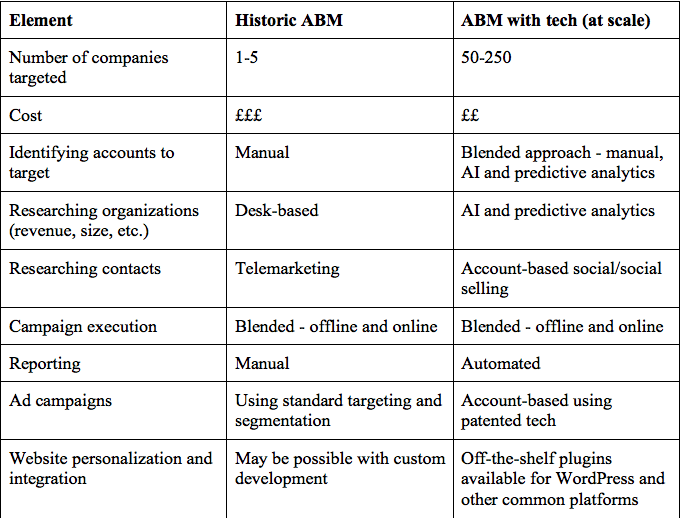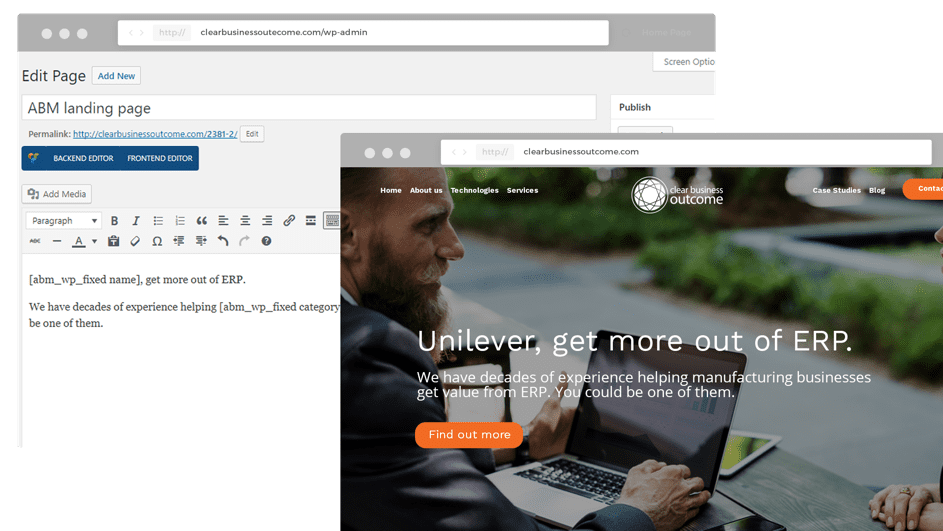Deciding on analogue vs digital is a crucial step in the ABM process
Although it’s a key phrase on the lips of many a Martech professional in Silicon Valley these days, account-based marketing (ABM) hasn’t always been about technology.
In its purest form, ABM is a strategy at the business marketing level – it’s about identifying the big white whales you want to snare, and investing time, money and effort into doing that, rather than casting a wider net for the minnows. In the past, it’s been largely thinking about selling to companies as a market of one.
However, the innovations of the last decade or so around IP-to-company matching, automation and retargeting, led by the likes of Kickfire, Demandbase and Terminus, have made the conversation about ABM very much one about technology.
As we know, technology is often about making things easier to do at scale. Enter “ABM at scale”.
Now that ABM is no longer an analog tactic and the technology to support at scale campaigns is readily available, even mid-market businesses and SMEs can set their sights on creating highly personalised digital campaigns to go after those whales.
All that being said, I thought a quick comparison table to look at the two strategies or approaches side-by-side would be useful here. Granted, there are a few generalizations. This is an inevitable side effect of compressing the vast history of a marketing strategy and comparing two varying approaches into a single three columned comparison table. Hopefully though, it will help to illustrate some of the key differences between these two ABM methods.
Okay, let’s unpack some of those one-liners a little bit.
Number of companies targeted
When we’re talking about traditional ABM, campaigns are focused on a very small number of accounts – sometimes, in the most extreme cases, one account. This strategy has been popular and proven mostly in enterprise-level businesses. And for them, it remains an approach that’s definitely worth considering and probably worth pursuing.
ABM powered by tech has a sweet spot of between 50 and 250 accounts. Anything under 50, and it’s unlikely you’ll get the scale you need to see any significant return. Anything over 250 and pursuing the level of personalization you need becomes pretty challenging, not to mention being very difficult to plug sales into.
Cost
Either approach to ABM is not a cheap option. So if that’s what you’re looking for, look elsewhere. That being said, if you’re interested in return-on-investment, you’ll get more back on every pound, euro or dollar you spend on ABM – whether that’s traditional or tech-led – than you will with any other business development or marketing strategy.
A traditional approach to ABM is problematic in this area because all of your eggs are essentially in one basket. This means that you could end up spending tens of thousands of pounds on a campaign which has one chance at converting, and if it doesn’t – you’re left with nothing but with a very big hole in your budget.
Scaling this up with tech-led ABM, you are able to hedge your bets. The costs may be similar, but as your reach will be anything up to 250 times that of traditional ABM, your returns can scale too.
Identifying accounts to target
Both traditional ABM and ABM at scale require an element of manual account targeting. This in practice means bringing your sales and marketing teams together to thrash it out and identify the accounts they want to go after with an ABM campaign.
This doesn’t just mean management and executive sponsors either – it means the do-ers too. The target-carrying sales team and the marketing executives. Rely solely on business intelligence and data from CRM for this activity at your peril. You must account for the potential lack of internal process and the very individual nature of how each salesperson goes about their business.
The best account targeting sessions I’ve seen are those where salespeople and marketers alike swap war stories and share wins and losses in a discussion driven by their passion for their craft and the business. This generates great energy for the project which you can deftly nurture to great success.
Tech-led ABM has a trick up its sleeve here too. It gives you the ability to augment those incredibly insightful human experiences with data the likes of which you or team have never seen. Platforms like Kickfire have firmographic databases that allow you to identify accounts based on a wide variety of characteristics. It takes a lot of the heavy lifting out of this part of the process.
If you want to dive into more detail on this topic, check out the article I wrote on how to build a target list for an ABM campaign.
Researching contacts
In traditional ABM, key contact identification has its roots in telemarketing. This used to be the only way to find out who the key decision makers and influencers were at your target accounts.
The advent of LinkedIn and Google has seen that off – the barriers to contact research have come down to significantly. Much more ground can be covered using online methods compared to telemarketing – and even if you still have to use telemarketing – it can be just be to plug the gaps rather than the be-all-and-end-all of the campaign.
Many of the tools in the space have some great technology that make this process easier. Kickfire, for example, has a platform called LIVE Leads, which comes complete with a contact database. This means that once you’ve used firmographic data to identify the target accounts, you can easily supplement this with details of the relevant contacts associated with those accounts.
This is often a vital step in the execution of your ABM campaign – it enables you to go to market with a strong “land-and-expand” strategy (engaging with a single person within the organization and then using a range of marketing tactics to broaden that relationship to other decision makers).
Campaign execution
At face value, there’s not much in it when it comes to campaign execution in traditional ABM compared with tech-led ABM. For years businesses have run ABM campaigns using a blended approach to execute across offline and online channels and tactics.
Where tech-led ABM has a slight upper hand here though is its ability to bring together the tactics that were historically manual processes and neatly automate them, often within a single suite of applications. Whether that’s powering display ads, search engine marketing or content personalization on your website, there are tools available to make your life easier.
For busy marketers, this means less time spent on admin and more time spent on creative. This can only ever be a good thing!
Reporting
This is one area where tech-led ABM has a big old home ground advantage over traditional ABM. It may seem a simple and straightforward task – report on the success of a marketing campaign into a single account. I’d give you that, yes, if it were a single channel campaign on a single media source, to an individual contact at a business in a single location.
That is never the case though. ABM was born out of complex, multinational organizations where more traditional industry/vertical-based marketing campaigns proved ineffective.
In reality – even within single account, there are a large number of locations, different contacts and decision-making units, and campaign execution across a wide variety of channels. The manual reporting overhead can get out of control.
As covered in a previous article, many ABM tools offer their own reporting platforms or easy out-of-the-box integration with other reporting tools such as Google Analytics. This means that the you can build your ABM campaign reporting right into your other digital marketing reporting.
Whether it’s website visits from your ABM lists, conversions or some other metric, you are able to see at an individual company level what’s working and what isn’t.
Ad campaigns
As marketers, we’ve honestly never had it so good or so easy when it comes to ad targeting. Specific platforms like Google and Facebook and wider display ad networks have given us more power than ever to be able to target based on demographics. Between the two ABM methods, there’s really only one winner when it comes to serving hyper-targeted, bespoke ads to the relevant accounts.
You guessed it – it’s tech-led ABM. It’s difficult to imagine how you could possibly go back to the other way of doing things when you’ve run online ad campaigns where you can not only target the industry, age group or interest – but also the company itself. This topic is covered more deeply in the ‘how to get ABM accounts to your website’ article.
Website personalization
This is tricky to achieve without the right technology at your disposal. It may be possible, using custom development, but it won’t be quick or easy. The very idea of an enterprise marketing team doing this seems unlikely anyway, but also, reverse IP lookup is not in itself a perfect technology – especially when multi-site, multi-location global businesses with firewalls and multiple data centres are involved.
Tech vendors have this nailed. Whatever CMS you’re using, whether it’s WordPress, Joomla or Magento, there are a range of tools available to make your website an ABM animal! This makes personalizing the content targeted accounts see when they come to your site as easy as creating a blog post or page.
Return
It’s quite difficult to measure the difference in return between traditional ABM and tech-led ABM. If a traditional ABM campaign manages to catch one very large whale, the return can be big in the order of magnitude that ABM at scale might never be able to touch. It depends on the business.
I would say though that both approaches give you opportunity to make big bucks for your business. Granted, there is potentially more reward to be gained from a traditional ABM campaign, but there is more risk, and they tend to comparatively cost more. I think for this one, there are few too many variables to make a definitive call either way.



